
Welcome back to our analysis of the Gen 1 move lists! It has been a longer-than-expected pause since the first part. Some new things were unexpectedly uncovered between then and now, which has given us the boon of a couple new revelations about the development of the move system.
First of all, the Blue source code was leaked among other things, meaning that we can now discuss files and their contents, i.e. where the move lists seem to have come from, and make further hypotheses based on what we find. We will not be posting actual code, for obvious reasons. We will, however, be retroactively adding the terminology to the previous article (and other articles as well, according to need) to help the two parts mesh together properly with all the new information, and, naturally, trying to figure out how all of these move files fit together. The shorthand romaji names for each move, sorted by list, are also viewable in the “Source” tab of the Excel sheet. Some additional files that provide move lists with minor differences have also been spotted in the code and slotted into our analyses.
Secondly, we figured out a few new ways of approaching the move lists’ organization and the reasoning behind them, and learned some new pointers along the way. You’ll find out the details once you plunge in…
Without further ado, we move onto the biggest puzzle regarding the file called:
SHINKA.SAV
Here’s our very detailed spreadsheet again, for reference.
We also recommend going back and reading the first article, just as a refresher.
So SHINKA.SAV, which we previously knew from the assets as Evolutions and Attacks, is a list of Pokémon in index order (no names included, unfortunately) that includes their evolutionary data (method of evolution and the next stage) as well as any moves acquired through leveling up. It happens to be an early copy of SHINKA.DAT, the file used for the final game’s evolutions and learnsets. Because these are only ‘learnable’ moves, ‘starting’ moves at level 1 are not listed at all in .SAV, and may not have been a consideration until later, as they are present in the final .DAT file. TM/HM moves were stored elsewhere and have no earlier copies to study.
Why this copy was included in the source is unknown, perhaps as a backup. SHINKA.DAT was finalized on 11/25/1995, about 3 months before the game’s release. There is no date on the .SAV version. And, in case you weren’t aware, shinka is the word for evolution in Japanese.
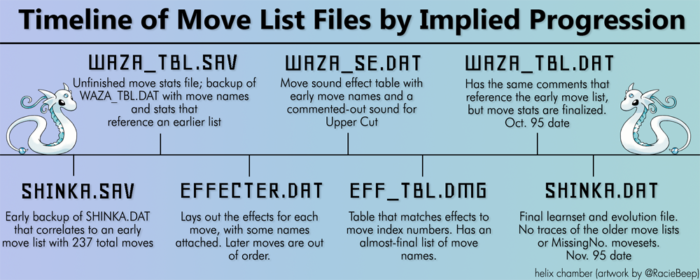
The data references move numbers up to 237, so there were over 200 moves in the game at this point. The final game has only 165 moves. Due to its immense length, this evolutions/attacks list most likely originates from a build older than the move lists that we covered in the previous article. Those subsequent move indexes were revised and cut back from the larger original iteration. This may explain why WAZA_TBL.SAV has many gaps and a few repeated entries: it’s a snapshot from the middle of an overhaul.
The learnsets are incomplete, having data for only 90/190 index slots, or about 60% of the final 151 used slots; while they are listed in index order going up to the assumed “cap” of 200, the list skips over several Pokémon. The monsters included span early Capumon like Nidoran, proceed to some middle-of-the-road 2b-era ones, like Mankey, and end with the beginnings of the Fire and Water starters near the very end of the index. A few monsters have false “data” which is actually just a 00,00 terminator at the end of every group of blank monsters, so they naturally haven’t been included.
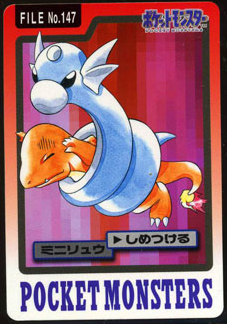
Conspicuously, the vast majority of Pokémon whose data are filled are early-game monster families – starters, early route and cave encounters, common fishing and Surf encounters. There are a few exceptions, such as the Dratini line, which may indicate revisions to how early some monsters were meant to be accessed – especially since Dratini only evolves at level 15 in this version.
Imagining it from the developers’ point of view, they seem to have started from Pokémon that appear in the early sections of the game as a framework, and gradually continued towards more powerful and rare monsters in later areas until all movesets were complete. They were around halfway done when this file was created.
An interview with Mr. Masuda in Retro Gamer #161, pp. 22 heralds an interesting quote about the move-making and learnset process, in fact:
We started by creating loads of different Pokémon designs, then we reduced that down to the favourite 150. That took a lot of effort. After that, once we were happy with our designs, we started working on the moves they could each use. This process probably accounted for around three of those six years. It was quite the task! There wasn’t an initial plan of which Pokémon would get which moves – we designed the Pokémon then designed the moves, then decided which would fit well together as a gradual process.
Junichi Masuda, Retro Gamer
We can see why there are so many iterations and different bits that comprise the corpus of known move data – it was a tenuous process that took years.
Something significant about the included Pokémon learnsets is that some of the monsters they belong to were later deleted: we have here some MissingNo movesets.
By examining the included MissingNos, we can almost pinpoint when they last updated this list before discarding it. A key monster is Wartortle’s proto-evolution (index 181). 181 is the last Pokémon in the list with non-blank data. It’s likely that this list became defunct around the same time that Wartortle’s evolution was changed to Blastoise. It also predates the Victreebel and Vileplume ‘filler Grass-type’ lines. With our tentative dating of the monster index, the file as it is was most likely to have been last edited at some point from 1994 up to mid-1995, before the monster list received a facelift for game balance and finalization, and said facelift came back to reflect on the move data.
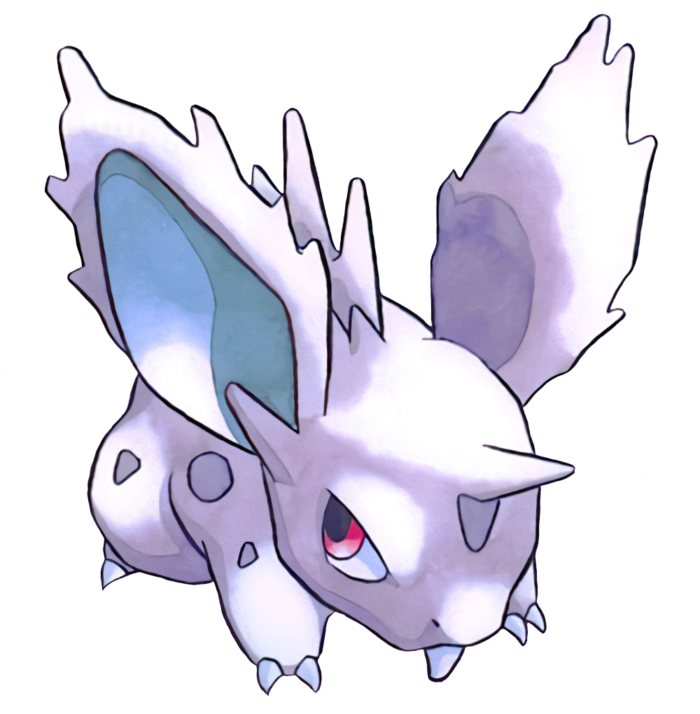
So while this “237 list” is very exciting, containing the learnsets of removed Pokémon, it is by no means decisive or certain as to defining these moves. How can this be?
Let’s look at Nidoran♂, the first monster on the list, for an example.
Here is Index 03 Nidoran♂’s learnset in final Red/Green/Blue:
| Level | Move |
| LV.01 | 43 Leer |
| LV.01 | 33 Tackle |
| LV.08 | 30 Horn Attack |
| LV.14 | 40 Poison Sting |
| LV.21 | 116 Focus Energy |
| LV.29 | 31 Fury Attack |
| LV.36 | 32 Horn Drill |
Here it is in the proto learnset list, if we use the same move IDs as the final move list:
| Level | Move |
| LV.09 | 40 Poison Sting |
| LV.11 | 45 Bite |
| LV.13 | 61 Bubblebeam |
| LV.15 | 53 Flamethrower |
| LV.17 | 62 Aurora Beam |
| LV.19 | 63 Hyper Beam |
| LV.21 | 49 Sonicboom |
| LV.23 | 59 Blizzard |
Doesn’t seem very accurate to Nidoran, does it…? Only a few moves seem to correspond, and many of them have been thrown around all over the place. Only Poison Sting is ‘correct’, but that appears to be a false positive. Several of these moves are also learnable by the Nidoran line, but as TMs rather than via level-up. This is why it is so difficult to parse what’s going on without doing some logistical reorganizing and a whole lot of “educated guesses”.
Here is Nidoran’s moveset again after using restoration methods that we’ll go into detail about later:
| Level | Move |
| LV.09 | 40 Sand-Attack |
| LV.11 | 45 Tackle |
| LV.13 | 61 Leer |
| LV.15 | 53 |
| LV.17 | 62 Bite |
| LV.19 | 63 Growl |
| LV.21 | 49 Thrash |
| LV.23 | 59 Poison Sting |
Several of these moves now match the final (Tackle, Leer, Bite, Growl, Thrash, Poison Sting), while others aren’t learned, but do fit Nidoran’s physical capabilities. A few still remain unidentified.
So… how did we get this from that?
Recovering the 237 List
Our goal was to recreate this nebulous early move list using SHINKA.SAV and all other move-related files and lists. Firstly, because the learnset list isn’t sorted by moves but by Pokémon index numbers, we had to recompile the data into something better to fit our purpose. We created two data tables: a chart that reverse-engineers the fragmented learnset list by comparing what monsters learned which slot with all later move lists (including the final), and a chart that lays out each monster’s moveset, organized by index and evolutionary family.
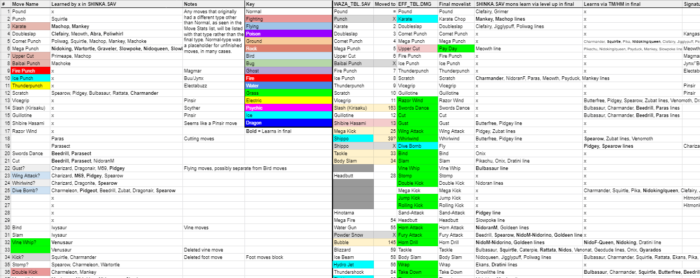

The first thing to establish with certainty is whether the final games’ list of 165 moves is indeed a heavily-revised descendant of this list, rather than a complete do-over. Checking the beginnings and endings of these lists is an easy way to find those parallels. The first 16 moves can be assumed to be nearly identical, for starters, as nearly every list attests to their presence. The final move in the early list, 237, is used by a large number of clawed Pokémon, leading us to believe that it was Slash, which occurs as one of the very last moves in the final move list (163). If the bookends are similar, whatever is between them might be as well.
Moves unique to a single Pokémon also can provide a lot of context. Move 227, learned exclusively by Meowth, was probably Fury Swipes (called Cat Nail in earlier lists). The distance between Fury Swipes and Slash is almost the same as in the final (10 vs. 9 slots), implying that the final move list was edited from the larger one in a way that still reflects the original… to a degree. Now with that established, we can continue on to how the original move list was organized.
The list can be separated into three general sections: generic physical moves, elemental type-based moves, and signature moves.
The first part of the list, from 000 to 073, is the same as you saw in Part 1 – physical moves. We have done some looking into older documents since Part 1, and now we know things a little more concretely. This part of the list, in fact, is an artifact of the early monster data structure, seen in planning storyboards, where a monster could learn normal physical moves in addition to one possibly unique “special” move (tokui waza). The beginning of the list shows common physical moves that monsters would have learnt aside from their singular special attack. We plan on making a full article about the original monster data structure and its implications, so stay tuned.
While we initially separated the first set of moves into categories that corresponded to final or near-final types, like Fighting, Bird, and Poison, these types did not exist when these first moves were coded in. Instead, the list is sorted by monsters’ physical attributes and capabilities.
The selection of moves in this part of the list greatly resembles the move sets of playable and enemy monsters in Square’s SaGa series. You may recall that the first SaGa was one of the first RPGs for Game Boy, and was one of the first RPGs in which enemy baddies were also playable as party members. For example, playable and enemy golems throw rocks and also get punches and kicks, bugmen learn bloodsucking moves, birds get wing and beak attacks, and plants can use vines and petals or absorb nutrients.
In the initial ideations for Capumon, special moves (seen as tokui waza) were separate from ordinary physical moves. Each monster having a single special attack was a significant distinction from SaGa’s system, where monsters are only as useful as the handful of moves that they come with, and the player must eat their way up to (possibly) stronger-tiered versions of monsters with better attacks. Unlike human and elven characters, who can equip weapons and other attack types, monsters must make do with their physical capabilities.
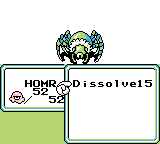
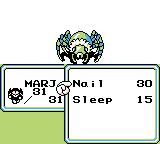
Here you can see two SaGa monster protagonists with different stats and abilities. The basic slime has only the Dissolve attack, and the basic demon has Nail and Sleep. Stronger tiers of these monsters have additional, more powerful attacks.
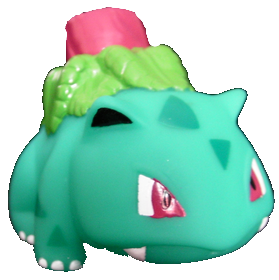
How does this fit in with Pokémon, though? Simply, it seems like Game Freak began with the same thought process where monsters should only learn moves that they can physically perform. Let’s use a common move as an example of physical traits; Bind is a good one. A Pokémon can only learn Bind if their body has some attribute capable of binding the enemy. This is why Ivysaur has Bind in its early learnset – it has vines that let it hold opponents. Bind, Slam, and Vine Whip are next to each other in the move indexes, most likely because they are capable of being learned by monsters who have vines and sometimes tentacles, and were thought up by developers around the same time.
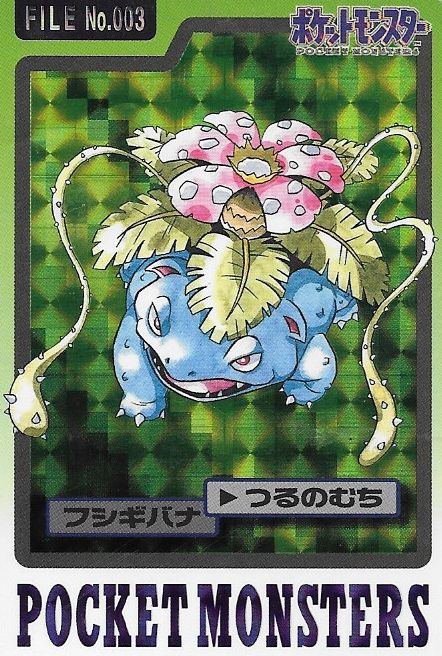
Later on, when types were introduced, the developers assigned Vine Whip as a Grass-type move, as only plants have vines, but left Bind and Slam as Normal-type for additional non-Grass monsters with tentacles or long bodies that could perform the same actions, such as Dragonair and Tentacruel.
This thought process is simple but essential to figuring out what move occupied each slot in the old 237 move index; all you have to do is investigate the physical characteristics of the Pokémon who learned them.
There is also a hazy, but still perceivable hierarchy of power present for these physical moves. This mirrors how, in SaGa, you can get more powerful versions of the same moves by becoming a more powerful monster of the same type. Most of these early moves were created and ordered by power, just like the elemental moves later in the list, where the connection is more obvious since they correspond almost directly to the final move index. We’ll use the three vine moves for a second example because, conveniently, they provide an easy example of this hierarchy: Ivysaur learns 030 Bind and 031 Slam, and then Venusaur gets 032 Vine Whip and 033, another (likely stronger) vine-related move. In the final games, different methods of evolution and B-button cancelling changed this hierarchy, meaning that higher-level unevolved Pokémon could learn these same stronger moves.
To summarize a few of the physical move categories, moves 018-021 seem to be cutting moves, 022-025 are all bird moves, 034-039 are all kicks, etc. Later groupings seem to include sound-based moves such as Growl and Sonicboom. Not all of the groups are easy to define, especially farther into this part of the list, since several move slots are learned by so many monsters that narrowing down exactly what the move is intended to be is impossible, and other slots have no learnset data at all or can’t be inferred from whatever moves surround it.
Let’s get down to brass attacks and define which moves are which in this first section. The good thing is that we already know the first sixteen moves in the list with near-certainty thanks to WAZA_TBL.SAV, which appeared to have kept the same archaic format. These moves must have been decided on very early on in the move timeline, and are nonspecific physical attacks. Many of them seem intended for the numerous early kaiju-like Capumon, with moves reminiscent of people in rubber suits pretending to beat each other up.
The first sixteen names in that list have several moves that we know from the final game – Pound, Karate (Chop), Double Slap, Comet Punch, Mega Punch, all the elemental punches, Scratch, Vicegrip, and Guillotine, plus a number of cut ones in between – Punch, Upper Cut, Baibai Punch, Kirisaku (the same as Slash, but with a different vowel ending), and Shibire Hasami. The only move that’s missing is the one that made it into the final at spot 006, Pay Day, which makes sense, as it did not exist until WAZA_SE.DAT, and was likely added long after the moveset list was made. The effect for Pay Day was added late into the game, as well. As for Pokémon that learn these attacks, the first eight are mostly learned by Fighting-types. It seems that the Squirtle line was originally envisioned to be more of a martial fighter, as Squirtle learned Punch at level 7 and Comet Punch at level 15, and then Wartortle learned Mega Punch at level 23. The rest of the contents in this section don’t stand out much, the biggest surprises being Slowpoke learning Mega Punch at level 25 despite being a quadruped, and the armless Poliwag learning Comet Punch at level 23; in the final, only their bipedal evolutions are capable of learning punches.
Next are the three elemental punches, and then a few moves that we associate with bladed or pincered monsters, like Guillotine and (early) Slash. None of the rare, late-game monsters that learn these moves have a learnset yet, so no data is present – we are just presuming that they’re there based on the other lists.
After the first 16, there’s a couple of techniques learned by the Paras line and some by Beedrill. The first two appear to have been completely deleted or moved – and may have been redundant cutting moves – but for 20 and 21, they match up perfectly to Swords Dance and Cut.
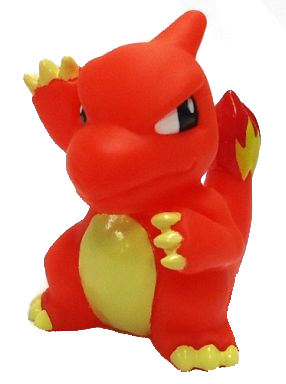
Moves 22-25 are all flying-related moves, most likely the same as the final’s 16-19, just slightly reordered. Charmeleon supposedly learning Dive Bomb/Fly at level 35 is a surprise here, but it’s not impossible that this move switched places with another, or was once something capable of being used by terrestrial Pokémon. Skipping over a blank section, the next four moves are learned by the Bulbasaur line, and appear to be vine or whip attacks. Despite our earlier example with Bind, the Bulbasaur line doesn’t actually learn Bind or Slam at all in the final version. Vine Whip is learned by Venusaur here, however, and is either slot 32 or 33, the other slot being a deleted vine move for Venusaur as well.
Next, we transition into foot and kicking moves, seemingly listed from least to most powerful. Five of these survived to the final (Stomp, Double Kick, Mega Kick, Jump Kick, Rolling Kick), and one did not: move 34, learned by Charmander and Squirtle at level 9, would probably be a basic weak Kick, similar to how there was a simple Punch at spot 2. This section further accentuates the Squirtle line’s fighting dispositions, as they learn several of the moves in this group.

Identities of moves in the “elemental” second part of the list (074-164) are somewhat easier to figure out: 074-076 are Fire moves, 077-079 are Water, and so on. The elemental moves appear to have been in the same type/strength order as later lists, including the final, making it rather lacking in new revelations. This block seems to have been the primary culprit of why the list was so drastically shortened when it was revised – it was overpopulated with more moves for each elemental type compared to the final, and later entries were offset by increasingly larger numbers as the list grew – and then shrank.
At lines 074 to 076, the Fire-type moves fit the 237 list perfectly – Honoo (Flame), then Flamethrower, then a move called Mega Fire, a likely precursor to Fire Blast. Mega Fire appears first in WAZA_TBL.SAV, at line 029 with Hinotama (Fireball) right before it – and then a second time at spot 076 in the same file, where we assume that it initially belonged. This copy seems to have survived the initial shortening of the big list, as EFF_TBL and WAZA_SE.DAT show it at spot 054, most likely after several moves were cut before it. In the final game, slot 54 was replaced by Mist, interestingly enough.
Speaking of elemental moves, there is an important revelation that we need to introduce here, which is that originally, only Fire, Water/Ice, and Electric-type moves were elemental types with weaknesses and resistances. While we had mulled over similar theories about the importance of these three types before due to various leftovers from this era, prior to December 2020, we had no concrete evidence of an original 3-element system. As it turns out, a monster stat development document seen in our favorite Game Informer interview video defined three unique resistance stats, for Fire, Water/Ice, and Electric moves, respectively. Thus, this section of the move list may be a remnant of the earlier concept for elemental moves. Mixing that with the Capumon-era idea of normal physical moves versus unique “special moves”, the first two parts of this list start to make more sense as to why they were organized in such a way.
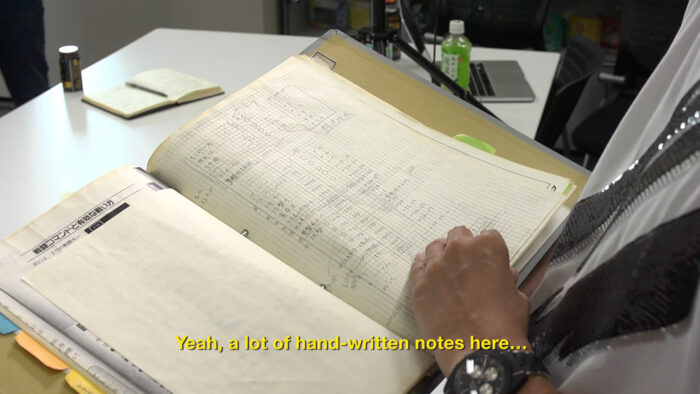
And on that note, the elemental sections that represent the final’s special attacks are interrupted frequently by blocks of what we’d now consider “physical moves”, such as the block at 087-096, which has Flying- and Fighting-type moves. Rather than seeing them as erratic gaps between types as we originally had done, perhaps these were stronger “signature/special” moves for physical-based monsters.
The one seeming spanner in the works for the “Fire/Water-Ice/Electric” theory is that Electric-type moves are a significant distance away from the Fire/Ice/Water moves in the 237 list; perhaps the developers started making more “signature moves” as the list went on, or perhaps some earlier iteration had the Electric-type moves closer to their other elemental counterparts. The document from the Game Informer video was likely to have been written years before the move list was created, or had even reached the point of revision that we are examining today. However, WAZA_TBL.SAV’s marginal name list has all three (four if you count Ice) of these elements bunched up together. It’s possible that WAZA_TBL could have preserved an earlier list in its comments that may even predate the 237 list, but there’s no solid proof…yet.
Additionally, there’s a very interesting block after the Ice-type moves. Starting with Aurora Beam and ending with Hyper Beam are a set of mostly elemental beam moves that aren’t really associated with anything else. These moves may have originally been a set of elemental moves of some type that were replaced later on in development, or perhaps a sort of “energy beam” special move category. The assumed Poison-type move is especially interesting for being in this category.
Let’s move on from wondering about lofty castles in the sky. There is still one final section to discuss, and it’s a big one. Establishing a border between the elemental second section and the “signature” final section is difficult in the final move list, but it’s even more so in the extended list of 237 moves. The original concepts of special moves and signature moves were once one and the same, so it’s unclear where things begin and end. And, since we only have roughly half of the learnsets to go off of, it’s hard to tell what is and isn’t meant for a singular Pokémon. A good guess for the divide is around the 160s, which start with a few more elemental moves that seem to match mystical or “dragon”-like Pokémon, then we get to move 166: a move learned only by Clefairy, possibly Metronome. That entire section looks quite odd and doesn’t really match up with the final list – the three elemental wall moves are seemingly replaced by the final’s physical/special wall moves and Haze. Because the wall moves are element-based and still have multiple monsters that learn them, we’re quite confident in assuming that the “signature” section starts right after that. Buckle up.
Signature Moves and You

The amount of content we need to talk about for the third part of the 237 list warrants its own section! Assuming that the second “part” of the move list starts at 166 and ends on move 237, there would be 72 moves in that section, compared to around 46 in the final. The early section of this part matches with the final list very well, even though the data we have is scarce. Move 178, move 184, and move 188 are the only ones with data attached, and that’s luckily enough to provide a framework. The Pokémon that learn them are, respectively, Grimer, Squirtle, and Abra. This corresponds 1:1 with moves within the range of 124-134 in the final move list, those being Sludge, Skull Bash, and Kinesis. (Yes, Abra doesn’t learn Kinesis while its evolutions do, but most of the rules about evolutions and what moves they can learn can be thrown out the window.) It’s astounding that despite the list losing about 30% of its content, this whole chunk seemingly remained intact. Thanks to that, we can reasonably assume that all moves in between those three were the same as they are in the final game.
This would place Fire Blast at number 180, as it is two spots after Sludge in the final list. Converted to hex, 180 gives us 0xB4, which is an unused HM pointer in the Gen I game data. The source code also specifically names this unused field move as Mega Fire, one we’ve seen before and an assumed precursor to Fire Blast. We can think of a number of exciting applications for a scorching field move. The fact that this pointer remains in the final game means that they scrapped the idea for Mega Fire/Fire Blast as an HM back when the list still contained a larger amount of moves, and they never bothered or maybe simply forgot to remove it after the list was shortened.
A sort of theory one can infer from this data is that the “signature moves” for each Pokémon in this section went in monster index order. This is helpful when thinking about how these moves were developed – a special move for each Pokémon set apart from its physical moves, as defined in the Capumon days? A signature move only one evolutionary family can learn? Either of these seems to work with how the later parts of this list seem to appear. We can, rather roughly, line it up. And, to boot, multiple sections of moves have parallels with the final data, but not all can be identified well enough to pinpoint anything useful.
The meatier part of the section, between moves 188 and 225, is especially lacking in evidence. The best we can guess is that move 222 learned by Grimer (later also Muk) was its almost-exclusive Acid Armor, which would make move 223 learned by Ekans a scrapped or moved technique. The index order goes 136 Muk, 137 MissingNo (“baby Gyaoon”), 138 Kingler.
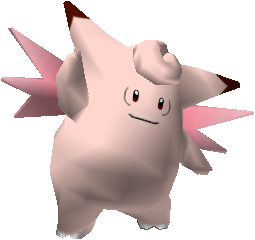
So, that Ekans move could have once been associated with MissingNo. 137 (baby Gyaoon), and the next one, move 224, would be Crabhammer associated with Kingler. And after that? Explosion for Golem, a mysterious move for Clefable (learned by Clefairy here for the same reasons as Abra/Kinesis), “Cat Nail” for Meowth, and so on. It starts to click like this for a little while, although we are still at the mercy of the incomplete list of learnsets – only so much can be garnered.
The gap between 228 and 235 needs to be accounted for – no Pokémon learn anything here, which makes sense since the signature moves in this section are for Pokémon whose learnsets aren’t finished. If our assumptions about Pokémon/move index parallels continue to apply, then seven of those moves would correspond to the moves between 155 and 161 in the final (with one exception we’ll cover later on). The identity of the eighth move remains unknown. It could have been located at any of those eight slots, too, since we don’t have any monsters to provide a benchmark. If we compare this to the monster index, a Pokémon between 144 Persian and 176 Charmander would have been associated with the removed attack. It could have been one that survived the cut (Ponyta with its TCG-exclusive moves comes to mind) or one of the MissingNos, like Kotora, but the possibilities are far too wide to narrow it down. Oh well.
The final two moves, 236 and 237, are much easier to identify. Move 236 is learned by Rattata and move 237 is, unusually (compared to the other signature moves), learned by several Pokémon, including Charmeleon. We already know 237 is Slash, but the move preceding it is undoubtedly Super Fang both here and in the final.
Cross-referencing with the Pokémon index list can only go so far. If we step back just a bit to some of the earlier signature moves, we can see where the usefulness of this theory begins to run out. Move 197 was learned only by 057 Mankey. That would place its move somewhere between Poison Gas (associated either with 048 Drowzee or 055 Koffing) and Barrage (probably associated with 067 Cactus). Of course, other than that, we know nothing about it, thus the journey ends.
The ultimate conclusion we can draw from this section is that many Pokémon from Periods 2b to 4a lost many moves associated with them. Despite the data lost in favor of balance and memory space, the developers retained a few moves that may have belonged to MissingNos – Piyo Piyo Punch, or Dizzy Punch, was probably a “signature” move of Missingno 080, while Flash, called Squid Ink in EFF_TBL and WAZA_SE, was in turn associated with the Kraken-like Missingno 122.
Reconstructing the Movesets of the MissingNos

Having worked extensively with this difficult data, we can point out patterns that shed a little insight on the included MissingNos’ movesets and types. Scrapped evolutions or pre-evolutions of existing Pokémon are fully intact, and we can see each line’s early move progression, including whether their other stages learned stronger or weaker moves as a result.
Notably, most movesets have a Pokémon learn a new move every two levels, with gaps around the level that evolution occurs at. This probably reflects the larger amount of moves at the time as well as a more rudimentary idea of how evolution would have worked. Later on, learned move levels are spaced out more dramatically. The introduction of B-button cancelling evolutions also affected how learnsets would work, calling for more repeated moves between evolutions, so that most moves are not missed by passing on evolving.
Because of the original nature of evolution and learnsets, there may also be cases where moves were designed with the final form in mind. In the final game, both Nidorans learn Tail Whip, even though we know that they have never had tails; meanwhile, Nidoqueen and Nidoking do. In Shinka.sav, Raichu learns Horn Drill; it may have been a victim of the same ‘final-first’ thought process, or it may have had a horn at one point in development to match Gorochu’s. Whether these moves reflected earlier designs remains unknown. We can also hearken back to Poliwag and Slowpoke learning those punching moves, and a few others you may have noticed along the way. Now let’s get on with it and look at those MissingNos.
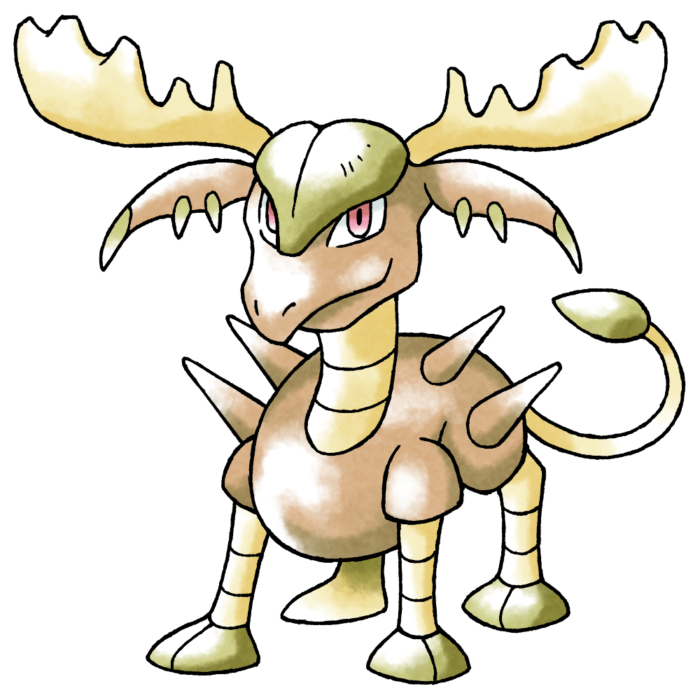
057 Deer’s moves are shared by a number of Psychic-types and Psychic-adjacent monsters like Venomoth, which lends significant credibility to it being revisited and redesigned to become Stantler in Generation II. It seemed to have had a lot of status moves and Jump Kick, as well.
069 (Zubat’s pre-evolution) seems to have a lot of low-level moves, seeing as it was originally an early-game cave dweller. Zubat, in turn, had stronger moves typical of a middle stage. Zubat was significantly downgraded when 069 was cut, borrowing a lot of its weaker moves.
079 and 080 (the fish/bird things) appear to share a lot of Fighting-type and Water-type moves, and thus may have been Water/Fighting themselves. 079 shares an unknown bird-based move with Pidgey and Spearow, so it may have a beak, something hard to tell when you only have a back sprite.
127 (Psyduck’s middle evolution) has a lot of middle-grade Water and Psychic-type moves, naturally. Similar to 069’s case, the progression of moves through the evolutions got redistributed when the middle evolution was taken out.
156, Goldeen’s pre-evolution (known in Gen II as Gyopin), learns Supersonic at level 17 and Horn Drill at 19. In Spaceworld, Gyopin learns Horn Drill at level 28, so the placement of this powerful move isn’t too out of the ordinary.
175 Gorochu has only a few moves it can learn, which makes perfect sense for a third stage monster. This list was actually what allowed us to identify its weird back sprite as Gorochu, since it was listed as evolving from Raichu.
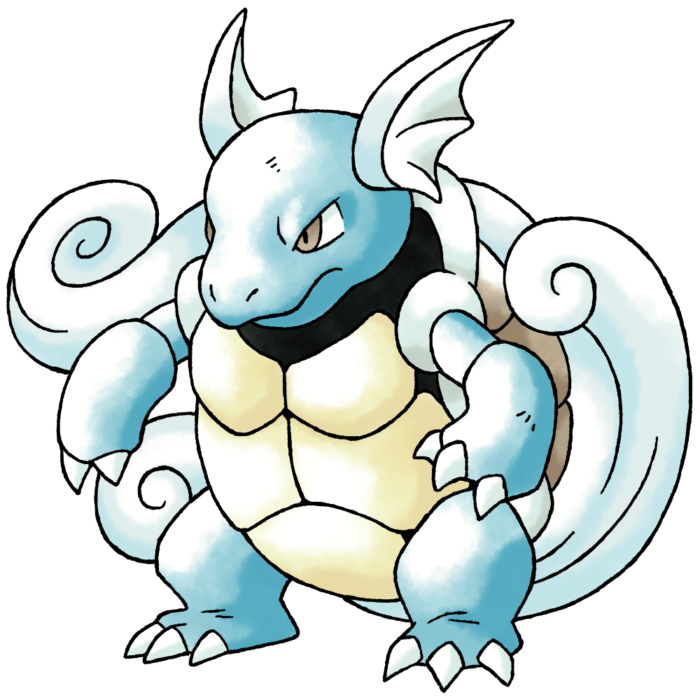
181 (Wartortle’s evolution) evolves very late at level 43, so it has just one learnable move, most likely Blizzard, that was exclusive to itself at the time. This was passed on into the final as a TM-learnable move for the Blastoise line. It’s also possible that Wartortle’s original evolved form was a Water/Ice type, as it has the only known Ice move in the entire list. (Aurora Beam was Water-type early on, according to WAZA_TBL.SAV, so it doesn’t count.) Or maybe it was Water/Fighting. Just frothing at the mouth thinking about a dual-type Blastoise.
Conclusions
We’ve reached the end of the line as to what we were able to fish out – something more than a nibble, but not quite the big one we were expecting that would put everything in its place. The Blue source didn’t help as much as we wish it could have (one can dream). The result of our trials over multiple years of staring at Excel sheets and ruminating on data structures was an interesting mess of moves that one could research forever and still never see the end result. That’s the other reason why this article took so long; no matter how “done” the article is, there’s always another move placement theory to slip in, or another way to approach the lists. It’s easy to tell that the overwhelming amount of move data created by the developers was chopped, revised, replaced, and mishmashed into the final moves that we know by heart. It’s also quite something to see some of the only known characteristics added to MissingNos before their bytes bit the dust.
Revisions to this list still happen today, in fact. In Sword and Shield, many Gen 1 moves were cut due to their redundancy within the modern game environment, like trimming an overgrown shrub. Other later-gen moves were cut as the features they were created for, like Z-Crystals, were no longer in the spotlight. Moves are such an essential part of Pokémon games that the study of their development reveals heaps about how the game was initially imagined and designed, and unfurls the reasoning behind several design choices. We hope you enjoyed this journey as much as we did. It’s not even over yet, by the way…
Sources
The SaGa / Final Fantasy Legend images are self-made screenshots.
We made heavy reference and use of the BIG Hex List from Glitch City Laboratories during our research due to its amazing usefulness.
All Sugimori-esque prototype monster drawings were made by the honorable RacieBeep.
The Nidoran Carddass card is from Hi-Res Pokémon. Give them a follow!
All miscellaneous images are from Bulbagarden Archives.
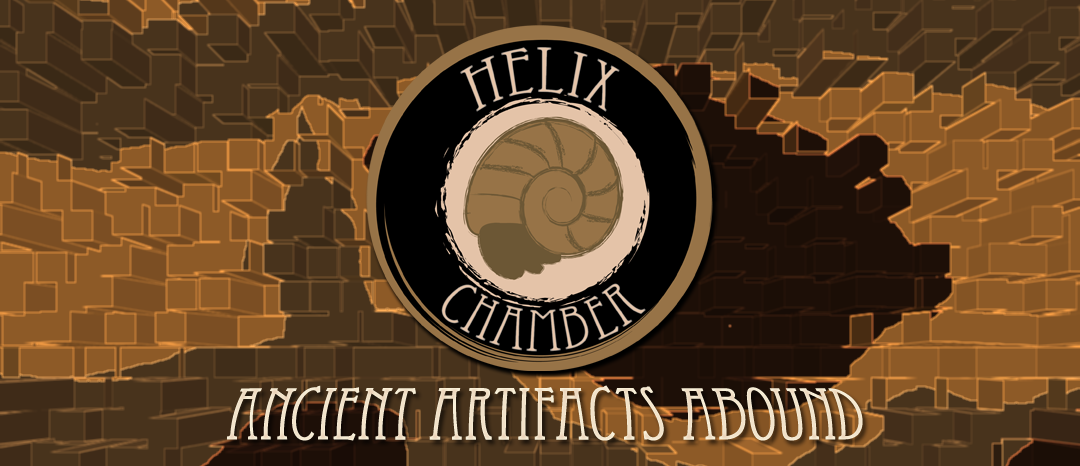
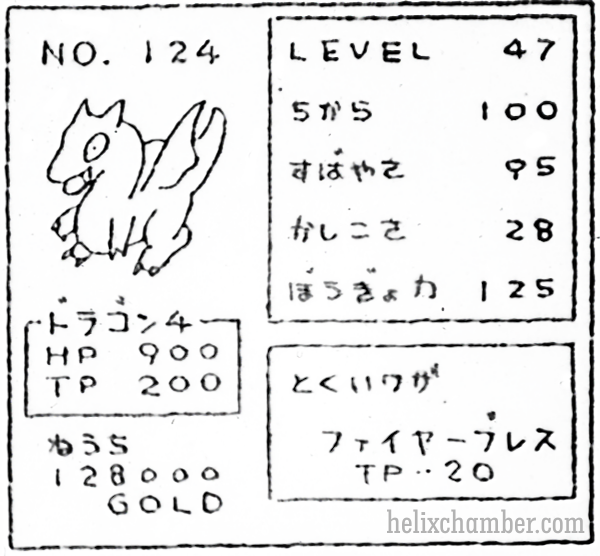

Any thoughts on Signature Moves which belong to the Missingnos? You mentioned Barrage may have belonged to Cactus
It’s hard to tell based on comparing the move and monster index lists, but there are a few obvious ones. Squid Ink surely belongs to MissingNo. 122 (the squid) and possibly its earlier evolution, 063. The other moves in the final signature section are seemingly already “taken” by monsters that are in the final game. The only real open spot in the final move list with a reasonable move-to-monster connection is 069, Pre-Zubat, and move 141, Leech Life. Otherwise, in the 237 list, there are so many blank spots in the signature section that anything could have been anywhere.
We can do some more research in the future, though; doing a more thorough comparison of signature moves to the monster index is on our to-do list.
I know I’m late to this party but I keep thinking about o.g. Kamex. As the only single-type starter, I wonder if part of the motivation for the change to Blastoise was that being Water/Ice made Kamex overpowered?
It also makes me wonder if being ice factors into the design at all. Clearly they didn’t think Water/Ice made sense for Blastoise design-wise, but was there something icy or snowy about o.g. Kamex? Maybe the tail is coupled with a long, flowing Santa-beard (inspired Delibird?) Obviously no way to know.
there are a few more oddities with moves in the blue source worth mentioning.
first off, the functionality to learn moves from TMs is referred as a “waza shop” in the code, right in between the “item shop” and the pokémon center functions that deal with the dialog (TALKMAP.DMG) which makes me wonder if it’s just quirky usage of english by non-native speakers or maybe learning moves was a very different process at some point, and it was more like something you bought for your pet rather than something learned through experience. In regards to Pokémon I’m very suspicious of any name with a number appended to its name (myuutsu anyone?) and I’m wondering if TMXX was for a while the placeholder name for special moves.
Move #53 gets referred as “fire kabe” on some places (like EFF_TBL.DAT) hinting at elemental walls. It would kind of explain why Haze defrosts monsters. Maybe the W in W Kabe stood for Water at some point?
considering flash seems to be a last minute adding to the movelist (replacing squid ink) maybe the fire field move was meant to light places, and was reworked exactly because of what you’re thinking of (a fire field move that just lights up caves? how disappointing… specially considering how rare fire types are in Gen I)
lastly, slightly offtopic and speaking of SaGa II… i think the league was modelled around the Pillar of Sky in SaGa II, as a tower you progressively climb during the game, unlocking new floors with each badge/title.
good reading as always, kept me waiting.
Hello, my name is Travis, I wanted to ask, are you guys planning on releasing the rest of the prototype data that wasn’t in the pokemon green helix chamber rom later in the future it’s a very amazing project.